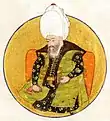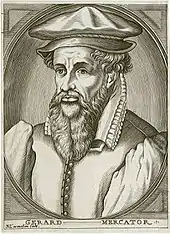1512
Year 1512 (MDXII) was a leap year starting on Thursday (link will display the full calendar) of the Julian calendar.
| Millennium: | 2nd millennium |
|---|---|
| Centuries: | |
| Decades: | |
| Years: |
| 1512 by topic |
|---|
| Arts and science |
|
| Leaders |
|
| Birth and death categories |
| Births – Deaths |
| Establishments and disestablishments categories |
| Establishments – Disestablishments |
| Works category |
|
| Gregorian calendar | 1512 MDXII |
| Ab urbe condita | 2265 |
| Armenian calendar | 961 ԹՎ ՋԿԱ |
| Assyrian calendar | 6262 |
| Balinese saka calendar | 1433–1434 |
| Bengali calendar | 919 |
| Berber calendar | 2462 |
| English Regnal year | 3 Hen. 8 – 4 Hen. 8 |
| Buddhist calendar | 2056 |
| Burmese calendar | 874 |
| Byzantine calendar | 7020–7021 |
| Chinese calendar | 辛未年 (Metal Goat) 4208 or 4148 — to — 壬申年 (Water Monkey) 4209 or 4149 |
| Coptic calendar | 1228–1229 |
| Discordian calendar | 2678 |
| Ethiopian calendar | 1504–1505 |
| Hebrew calendar | 5272–5273 |
| Hindu calendars | |
| - Vikram Samvat | 1568–1569 |
| - Shaka Samvat | 1433–1434 |
| - Kali Yuga | 4612–4613 |
| Holocene calendar | 11512 |
| Igbo calendar | 512–513 |
| Iranian calendar | 890–891 |
| Islamic calendar | 917–918 |
| Japanese calendar | Eishō 9 (永正9年) |
| Javanese calendar | 1429–1430 |
| Julian calendar | 1512 MDXII |
| Korean calendar | 3845 |
| Minguo calendar | 400 before ROC 民前400年 |
| Nanakshahi calendar | 44 |
| Thai solar calendar | 2054–2055 |
| Tibetan calendar | 阴金羊年 (female Iron-Goat) 1638 or 1257 or 485 — to — 阳水猴年 (male Water-Monkey) 1639 or 1258 or 486 |
.JPG.webp)
April 11: Battle of Ravenna
Events
January–June
- Mid-January – Following the death of Svante Nilsson, Eric Trolle is elected the new Regent of Sweden. He is, however, ousted after only six months in favour of Sten Sture the Younger.[1]
- February 18 – War of the League of Cambrai: The French carry out the Sack of Brescia.
- April 11 – War of the League of Cambrai – Battle of Ravenna:[2] French under Gaston of Foix, Duke of Nemours, defeat the Spanish under Raymond of Cardona, but Gaston is killed in the pursuit.
- May 3 – The Fifth Council of the Lateran begins.
- May 12 – Thomas Howard, 2nd Duke of Norfolk, leads an English expedition into France and burns the port city of Brest.[3]
- May 26 – Selim I succeeds Bayezid II, as Sultan of the Ottoman Empire.
July–December
- July 23 – Sten Sture the Younger is elected new Regent of Sweden, deposing Eric Trolle.[1]
- August 10 – War of the League of Cambrai – Battle of Saint-Mathieu: The English navy defeats the French-Breton fleet. Both navies use ships firing cannons through ports, and each loses its principal ship — Regent and Marie-la-Cordelière — through a large explosion aboard the latter.
- Summer – War of the League of Cambrai: Ferdinand II of Aragon sends Don Fadrique de Toledo, to complete the Spanish conquest of Iberian Navarre.
- October 19 – Martin Luther becomes a doctor of theology (Doctor in Biblia).[4]
- October 21 – Martin Luther joins the theological faculty of the University of Wittenberg.[4]
- November 1 – The ceiling of the Sistine Chapel, painted by Michelangelo Buonarroti, is exhibited to the public for the first time.
- December 27 – The Spanish Crown issues the Laws of Burgos, governing the conduct of settlers with regard to native Indians in the New World.
Date unknown
- António de Abreu discovers Timor Island, and reaches the Banda Islands, Ambon Island and Seram.
- Francisco Serrão reaches the Moluccas.
- Francisco Serrao and other shipwreck sailors with permission from the Ternate Sultanate build Fort Tolukko. It is one of the earliest, if not the first European style fortress in southeast Asia.
- Juan Ponce de León discovers the Turks and Caicos Islands.[5]
- Pedro Mascarenhas discovers Diego Garcia, and reaches Mauritius in the Mascarene Islands.
- Moldavia becomes a vassal of the Ottoman Empire, on the same conditions as Wallachia: the voivode will be designated by the Turks, but will be Eastern Orthodox Christians. Also, the Turks are not allowed to build mosques, to be buried, to own land or to settle in the country.
- The Florentine Republic begins to be dismantled, and the Medici Family comes back into power.[6]
- The word masque is first used to denote a poetic drama.
- Possible date – Nicolaus Copernicus begins to write Commentariolus, an abstract of what will eventually become his heliocentric astronomy De revolutionibus orbium coelestium; he sends it to other scientists interested in the matter by 1514.[7][8][9]
Births
.jpg.webp)
Sibylle of Cleves
- January 13 – Gaspar de Quiroga y Vela, General Inquisitor of Spain (d. 1594)
- January 17 – Sibylle of Cleves, electress consort of Saxony (d. 1554)
- January 31 – Henry, King of Portugal and Cardinal (d. 1580)[10]
- February 3 – John Hamilton, archbishop of St Andrews (d. 1571)
- February 22 – Pedro Agustín, Spanish Catholic bishop (d. 1572)
- March 5 – Gerardus Mercator, Flemish cartographer (d. 1594)
- April 10 – James V of Scotland, King of Scots (d. 1542)[11]
- April 23 – Henry FitzAlan, 19th Earl of Arundel, Chancellor of the University of Oxford (d. 1580)
- April 30 – George II, Duke of Münsterberg-Oels, Count of Glatz (d. 1553)
- July 5 – Cristoforo Madruzzo, Italian Catholic cardinal (d. 1578)
- July 25 – Diego de Covarubias y Leyva, Spanish jurist, Roman Catholic prelate, Archbishop of Cuenca (d. 1577)
- August ? – Catherine Parr, English queen consort (d. 1548)[12]
- August 27 – Friedrich Staphylus, German theologian (d. 1564)
- November 4 – Hu Zongxian, Chinese general (d. 1565)
- November 9 – Jon Simonssøn, Norwegian humanist (d. 1575)
- November 11 – Marcin Kromer, Prince-Bishop of Warmia (d. 1589)
- December 21 – Boniface IV, Marquess of Montferrat, Italian nobleman (d. 1530)
- date unknown
Deaths

Sultan Bayezid II

Alessandro Achillini
- January 2 – Svante Nilsson, regent of Sweden since 1504 (b. 1460)[1]
- January 30 – Reinhard IV, Count of Hanau-Münzenberg (1500–1512) (b. 1473)
- February 2 – Hatuey, Puerto Rican Taíno chief
- February 22 – Amerigo Vespucci, Italian merchant and cartographer, after whom the Americas are named (b. 1451)
- March 29 – Lucas Watzenrode, Prince-Bishop of Warmia (b. 1447)
- April 11
- May 21 – Pandolfo Petrucci, ruler of Siena (b. 1452)
- May 26 – Bayezid II, Ottoman Sultan (b. 1447)
- June 20 – Goto Yujo, Japanese swordsman and artisan (b. 1440)
- August 2 – Alessandro Achillini, Italian philosopher (b. 1463)
- August 15 – Imperia Cognati, Italian courtesan (b. 1486)
- September 15 – John Stewart, 1st Earl of Atholl, Scottish peer (b. 1440)
- September 29 – Johannes Engel, German doctor, astronomer and astrologer (b. 1453)[14]
- October 5 – Sophia Jagiellon, Margravine of Brandenburg-Ansbach, Polish princess (b. 1464)
- October 31 – Anna of Saxony, Electress of Brandenburg (b. 1437)
References
- Carl Georg STARBÄCK (1864). Öfversigt af riksföreståndarskapet i Sverige under unionstiden, etc. pp. 22–23.
- Augustiniana. Augustijns Historisch Instituut. 1977. p. 202.
- "Fires, Great", in The Insurance Cyclopeadia: Being an Historical Treasury of Events and Circumstances Connected with the Origin and Progress of Insurance, Cornelius Walford, ed. (C. and E. Layton, 1876) p28
- Eric W. Gritsch (May 1, 2009). Martin - God's Court Jester: Luther in Retrospect. Wipf and Stock Publishers. p. 10. ISBN 978-1-72522-571-8.
- Turks & Caicos Islands: Report for the Years ... H.M. Stationery Office. 1961. p. 45.
- Quentin Skinner (November 30, 1978). The Foundations of Modern Political Thought: Volume 1, The Renaissance. Cambridge University Press. p. 153. ISBN 978-0-521-29337-2.
- Grun, Bernard (1991). The Timetables of History (3rd ed.). New York: Simon & Schuster. p. 229. ISBN 0-671-74919-6.
- Gingerich, Owen (2004). The Book Nobody Read: Chasing the Revolutions of Nicolaus Copernicus. New York: Walker. ISBN 0-8027-1415-3.
- Koyré, Alexandre (1973). The Astronomical Revolution: Copernicus – Kepler – Borelli. Ithaca, NY: Cornell University Press. ISBN 0-8014-0504-1.
- Thomas Spencer Baynes (1880). The Encyclopedia Britannica: A Dictionary of Arts, Sciences, and General Literature. Samuel L. Hall. p. 671.
- Lynch, Michael (ed.). The Oxford companion to Scottish history. Oxford University Press. p. 353. ISBN 9780199693054.
- Queen Catharine Parr (June 30, 2011). Katherine Parr: Complete Works and Correspondence. University of Chicago Press. p. 5. ISBN 978-0-226-64724-1.
- Gareth Ffowc Roberts (February 15, 2016). Count Us In: How to Make Maths Real for All of Us. University of Wales Press. p. 22. ISBN 978-1-78316-797-5.
- Trimble, Virginia; Williams, Thomas R.; Bracher, Katherine; Jarrell, Richard; Marché, Jordan D.; Ragep, F. Jamil (September 18, 2007). Biographical Encyclopedia of Astronomers. Springer Science & Business Media. p. 339. ISBN 978-0-387-30400-7.
This article is issued from Wikipedia. The text is licensed under Creative Commons - Attribution - Sharealike. Additional terms may apply for the media files.

